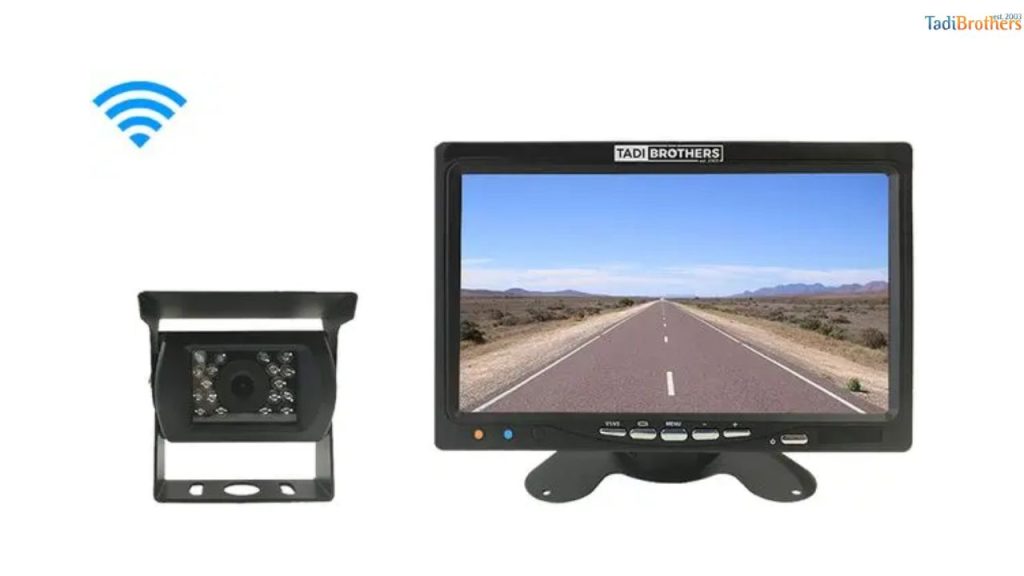Today’s driving conditions call for advanced safety solutions. With wireless backup cameras, avoiding accidents and reversing confidently has never been easier.
These systems provide real-time video without complicated wiring, making them a practical upgrade for any vehicle including RVs, trucks, and trailers.
What is a Wireless Backup Camera and Monitor?

A wireless backup camera and monitor mainly has 2 components one is the rear-mounted camera, the other is the display screen. These cameras help you see in real time as it transmits video to the monitor without running long cables through the vehicle.
The installation process is much simpler than you think while delivering a strong and stable video feed.
Benefits of a Wireless Rear View Mirror Backup Camera
There are several benefits that come with the Wireless Rear View Mirror Backup Camera.
- This camera improves visibility and lets you work through tight spaces.
- Helps in detecting pedestrians, obstacles, and other vehicles hidden in blind spots.
Some of the Wireless Rear View Mirror Backup Camera even includes night vision, making it easier to drive safely after dark. Gridlines on the screen guide reversing and parking, giving drivers more confidence in tricky maneuvers.

Key Features to Look For
When selecting a wireless backup camera with monitor, certain features can make a big difference in usability and safety:
- Full-Color Display – Clear images both during the day and in low-light settings.
- Strong Wireless Signal – Works up to 70 feet without requiring line of sight.
- Mirror Image View – The video appears like a traditional mirror for intuitive use.
- Weatherproof Design – Built to withstand rain, snow, heat, and dust.
- Dual Use – Works both while reversing and while driving forward as an observation camera.
- Night Vision – Ensures visibility in complete darkness.
- Bird’s-Eye Mounting – Can be positioned high for a wide view of the road.
- Multiple Camera Support – Switch between two or more cameras directly on the monitor.
- Flexible Screen Sizes – Often includes a 7-inch display with mounting options for the dash, windshield, or overhead.
- Expandable System – Start with one camera and add up to four for complete coverage.
Installation Process
One of the biggest advantages of these systems is how simple they are to set up. The camera is usually mounted above the license plate or on the rear bumper. It connects to the reverse light for power so that it activates automatically when backing up. The monitor can be mounted on the dashboard, attached with a suction cup to the windshield, or placed overhead depending on driver preference.
For larger vehicles such as RVs, a wireless backup camera for RV with rear view monitor is particularly useful. It removes the hassle of running cables across long vehicle bodies and ensures the driver has a clear view of what’s behind before reversing or changing lanes.
You can also check the video on Quick guide on how to install and pair a multi camera digital wireless backup camera system
Wireless vs. Traditional Backup Cameras
Traditional wired cameras have a lot of running cables through the vehicle, the installation can be very time-consuming and complex.
On the other hand, wireless backup camera systems avoid these challenges, easier to relocate if needed. There are less cables included and modern wireless options include additional features such as multi-camera support along with real-time observation while driving.
Maintaining Your Wireless Mirror Backup Camera
Regular care ensures your system works reliably. Clean the lens often to remove dirt, dust, or water spots. Check that the camera is firmly mounted and doesn’t vibrate loose over time.
Occasionally, test the monitor and wireless connection to make sure the video feed is stable. A little maintenance keeps the system performing well for years.
Common Issues and Solutions
Like any technology, backup cameras can face small issues like Signal interference or weak power connections that may cause the video to flicker. A foggy or dirty lens can reduce clarity, especially in rain. Most of these issues are simple to fix by cleaning, checking connections, or re-pairing the camera with the monitor.
Enhancing Vehicle Safety
A wireless backup camera with monitor is more than just a convenience. It plays an important role in accident prevention.
By improving rear visibility, drivers are better able to avoid collisions with obstacles, vehicles, or pedestrians. For those towing trailers or maneuvering large vehicles, the system provides real-time guidance and helps reduce blind spots.
Whether driving a compact car or maneuvering a large RV, systems like a wireless backup camera for RV with rear view monitor provide drivers with the confidence to reverse safely, avoid obstacles, and improve overall visibility.
Conclusion
Upgrading to a wireless backup camera with monitor improves both safety and convenience. The new tech offers many new features like HD video, night vision, weatherproofing, and wide viewing angles that make them extremely reliable in almost every driving condition.
Whether you are driving long-distance on an RV, or parking in reverse, these camera systems offer you a lot of support and help you reduce blind spots, simplifying driving. With regular maintenance, they remain dependable for years, helping drivers stay safe and confident on the road.
